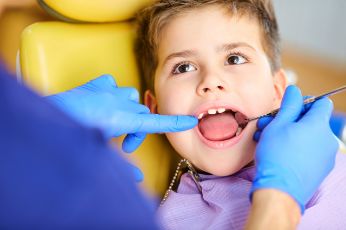
Dental emergencies are stressful and scary, particularly when kids are involved. And whether it’s a sports injury, an orthodontic emergency like a broken bracket, or a toothache, children can experience sudden dental pain at any time. In these situations, the first thing you should do is call a children’s dentist to advise you over the phone and schedule the first available appointment. In the meantime, use the tips below for handling 3 common pediatric dental emergencies.
1. Orthodontic Emergencies
- Poking wire – If a wire is poking your child’s lips, cheeks or gums, use a small piece of orthodontic wax or dental cement from the drugstore (or even sugar-free gum in a pinch) to cover the end of it. Then make an appointment to have it adjusted.
- Generalized soreness – Temporary soreness or sensitivity to biting pressure is common in the days after an adjustment (or when orthodontic treatment first begins). To relieve discomfort, give your child over-the-counter pain reliever as directed.
- Loose or broken bracket – You can use orthodontic wax or dental cement from the store to stabilize the bracket, but don’t use any other type of glue or adhesive, because it can do more harm than good. The goal is to prevent the bracket from moving freely around on the wire, causing irritation, or becoming a choking hazard until an orthodontist can fix it.
2. Knocked-Out Teeth
With a knocked-out tooth (particularly a permanent tooth), time is of the essence. Preferably you should see a children’s dentist within one hour, so be sure to call right away. From there, use the following tips to manage the injury:
- Handle the tooth by the crown, not the root, and gently rinse it off with water.
- It’s critical to keep the tooth moist to keep it “alive.” Ideally, you can put it in a glass of milk. If not, kids over 12 can hold it in their cheek pouch (children younger than that are at greater risk of swallowing it). Only store it in tap water as a last resort.
- Have your child gently but firmly hold a clean, damp cloth on the area to reduce bleeding until you can be seen.
3. Toothaches
Toothaches range from mild to severe and can be caused by cavities, fractures, or food wedged between the teeth. First, look in your child’s mouth (using a flashlight if necessary). If you see anything stuck, gently floss the area.
If you don’t see anything and the pain persists, have them swish with lukewarm saltwater, apply a cold compress to their lip or cheek, and give them over-the-counter pain medication as directed.
But keep in mind that, even if their pain goes away, you still need to schedule an appointment. They might have a dental infection that can become very dangerous if left untreated.
As a parent, there’s nothing worse than seeing your child in pain. But by calling a children’s dentist right away and using these tips to handle the situation, you’ll help them feel better fast!
About the Author
As a children’s dentist, Dr. Hyun Jeong Lee is a graduate of New York University and also a mother of one. She and her team have the training, technology and experience to treat a wide variety of pediatric dental emergencies and put kids at ease in any situation. If your child is having a dental emergency or you have any questions, she can be reached via her website.
